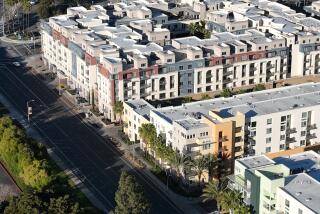Column: Reports of California’s demise are greatly exaggerated. Lawmakers should care anyway
Ever since the middle of May, it has been the same thing over here on the Westside of Los Angeles.
Beep! Beep! Beep! Beep!
Multiple times a week, I hear the telltale sound of a moving truck backing into the loading area of my building, accompanied by the occasional crash and shout. At this point, I’ve lost track of just how many of my neighbors, as well as others on my block, have moved out their mostly patio-less condos and apartments.
One told me that he and his wife were packing up and heading to their second home somewhere in the presumably remote Sierra. Another said he was moving to the cheaper desert pastures of Arizona. Yet another left the state — headed back to the Midwest, I think — to be closer to family.
So it wasn’t at all surprising to read the latest report from the California Department of Finance, which found that population growth in the state had slowed to a crawl as fewer people moved here, more people moved away and fewer people were born.
California had a net gain of a just 21,200 residents between July 2019 and July 2020. Anyone who remembers the last recession knows that migration is cyclical. But the growth rate, according to the report, is at 0.05% — a percentage so paltry that it hasn’t been recorded since 1900.
Los Angeles, the state’s most populous county, logged the biggest net loss with about 40,000 fewer residents.
So cue the hot takes about California’s coming demise. I can already imagine the overwrought headlines, especially after the collection of wealthy tech executives — including SpaceX’s Elon Musk, Oracle’s Larry Ellison and Dropbox’s Drew Houston — who have moved themselves and, in some cases, their companies to Texas.
“If a team has been winning for too long, they do tend to get a little complacent, a little entitled, and then they don’t win the championship anymore,” Musk recently told the Wall Street Journal. “California’s been winning for a long time. And I think they’re taking them for granted a little bit.”
I hate to give megalomaniacs more reasons to feel good about themselves, but Musk does have a point. The population trends highlighted in the Department of Finance’s report aren’t new, but they are accelerating.
And although there is no mass “exodus” — roughly 40 million people still live in California — lawmakers returning to Sacramento this month would be wise to address their complacency about the state’s high housing costs and other affordability issues. Now is the time to stop nipping around the edges and finally do something substantial.
So far, though, the rhetoric has been mostly disappointing.
Asked to explain the slowing population growth, state officials blamed low birth rates and wildfires. But above all, they pointed to the COVID-19 pandemic for killing thousands of Californians and also presumably keeping thousands of other would-be Californians from moving here.
I am not entirely convinced of that. Neither is Dowell Myers, a professor and director of the Population Dynamics Research Group at USC.
“I hope they do not see it as a symptom of COVID,” he said. “Because then they’ll think, ‘Ah, a vaccine! We’ve got that covered now.’ That’s the danger. COVID is what’s newsworthy, but COVID is not what’s going on in this report.”
It’s about affordability, Myers added.
And yet, state officials pointed to the hundreds of thousands of mostly well-off people who continue to move here as proof that there is still strong demand to live in California. Indeed, ever since the Great Recession, those migrating here have tended to have higher incomes while those leaving tend to have lower incomes.
Today, home prices are hovering at record levels in California, with would-be buyers who can afford a bigger living space engaging in bidding wars in what is already a tight market. Interest rates on mortgages have dropped that low, even as the unemployment rate has remained in double digits and surging coronavirus cases have shut down parts of the economy again.
The only thing that COVID-19 is actually doing — other than overloading hospitals and causing mass suffering — is widening the already yawning chasm of income inequality.
Is that really the kind of state that we want? For California to be a place where the only residents are wealthy people and poor people who, even if they wanted to, couldn’t afford to leave? Or a state where even a bigger slice of the rich own multiple homes while others own nothing?
Another, perhaps more pressing, question for state lawmakers is how long this will last.
With herd immunity from COVID-19 still months away and the prospect that working from home will continue a lot longer than that for many people, the temptation to move out of California will remain — especially as long as living here means fighting over a two-bedroom bungalow going for close to $1 million.
This is increasingly true even for people with higher incomes who call the Bay Area and Southern California home, said David Garcia, policy director at UC Berkeley’s Terner Center for Housing Innovation.
“Even though they may make a pretty significant salary in California, I think they realize that a lot of their income may be going to housing where in other places that may not,” he said. “Just because they can afford to live here doesn’t mean anything.”
So a lot is riding on what the Legislature can accomplish.
The last session, cut short by COVID-19, was a bit of a bust for housing bills, including Senate Bill 50, which would have dramatically increased home building, and Senate Bill 1120, which would have essentially ended single-family zoning by allowing duplexes on most lots. This session must be different.
“Part of the strategy moving forward,” Garcia said, “has to be about how do we continue to move the pipeline of housing forward?”
More to Read
Sign up for Essential California
The most important California stories and recommendations in your inbox every morning.
You may occasionally receive promotional content from the Los Angeles Times.







